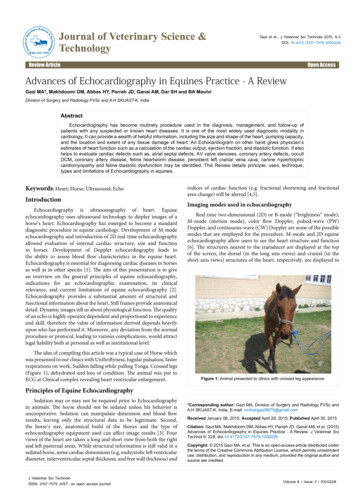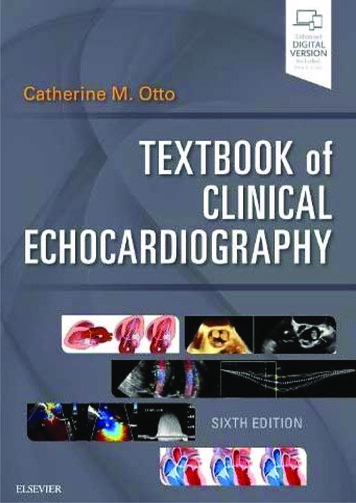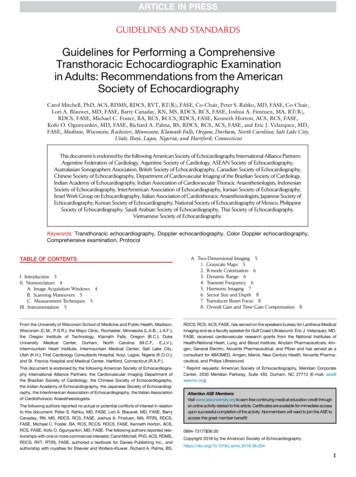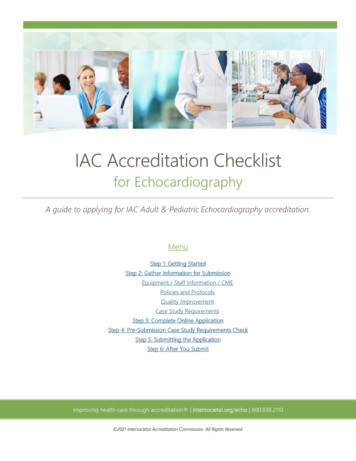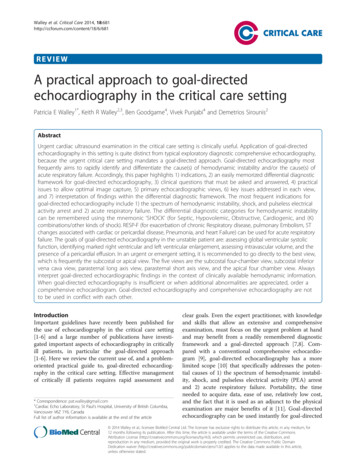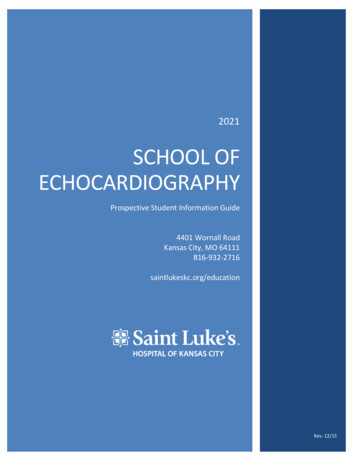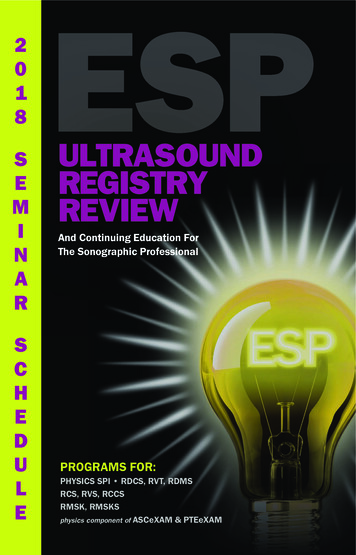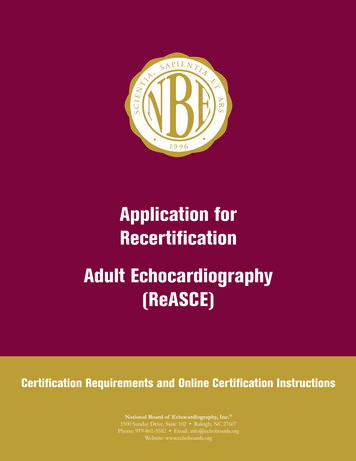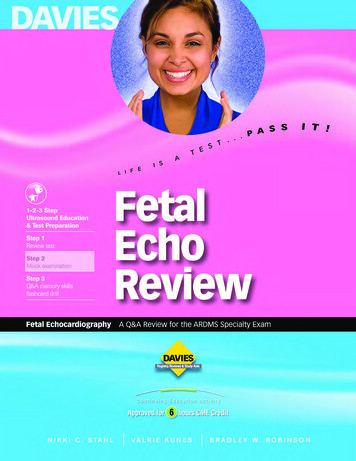
Transcription
EXPERT CONSENSUS STATEMENTBasic Perioperative TransesophagealEchocardiography Examination: A ConsensusStatement of the American Societyof Echocardiography and the Societyof Cardiovascular AnesthesiologistsScott T. Reeves, MD, FASE, Alan C. Finley, MD, Nikolaos J. Skubas, MD, FASE,Madhav Swaminathan, MD, FASE, William S. Whitley, MD, Kathryn E. Glas, MD, FASE,Rebecca T. Hahn, MD, FASE, Jack S. Shanewise, MD, FASE, Mark S. Adams, BS, RDCS, FASE,and Stanton K. Shernan, MD, FASE, for the Council on Perioperative Echocardiography of the American Societyof Echocardiography and the Society of Cardiovascular Anesthesiologists, Charleston, South Carolina; New York,New York; Durham, North Carolina; Atlanta, Georgia; Boston, Massachusetts(J Am Soc Echocardiogr 2013;26:443-56.)Keywords: Transesophageal echocardiography, Basic certificationTABLE OF CONTENTSIntroduction 443History 444Medical Knowledge444From the Medical University of South Carolina (S.T.R., A.C.F.); Weill-Cornell MedicalCollege, New York, New York (N.J.S.); Duke University, Durham, North Carolina(M.S.); Brigham’s and Women’s Hospital, Harvard Medical School, Boston,Massachusetts (S.K.S.); Emory University, Atlanta, Georgia (W.S.W., K.E.G.);Columbia University College of Physicians and Surgeons, New York, New York(R.T.H., J.S.S.); and Massachusetts General Hospital, Boston, Massachusetts (M.S.A.).The following authors reported relationships with one or more commercial interests: Scott T. Reeves, MD, FASE, edited and receives royalties for A Practical Approach to Transesophageal Echocardiography and The Practice of PerioperativeTransesophageal Echocardiography: Essential Cases (Wolters Kluwer Health).Kathryn E. Glas, MD, FASE, edited and receives royalties for The Practice of Perioperative Transesophageal Echocardiography: Essential Cases (Wolters KluwerHealth). Stanton K. Shernan, MD, FASE, has served as a lecturer for Philips Healthcare, Inc., and is an editor for e-Echocardiography.com. All other authors reportedno actual or potential conflicts of interest in relation to this document.Members of the Councils on Perioperative Echocardiography are listed in theAppendix.Attention ASE Members:The American Society of Echocardiography (ASE) has gone green! Visit www.aseuniversity.org to earn free continuing medical education credit through anonline activity related to this article. Certificates are available for immediateaccess upon successful completion of the activity. Nonmembers will needto join the ASE to access this great member benefit!Training 445Basic Perioperative Transesophageal Examination 445ME Four-Chamber View 446ME Two-Chamber View 447ME Long-Axis (LAX) View447ME Ascending Aortic LAX View447ME Ascending Aortic SAX View447ME AV SAX View 447ME RV Inflow-Outflow View 447ME Bicaval View448TG Midpapillary SAX View449Descending Aortic SAX and LAX Views 450Indications450Global and Regional LV Function451RV Function 451Hypovolemia 452Basic Valvular Lesions 452Pulmonary Embolism (PE)452Neurosurgery: Air Embolism452Pericardial Effusion and Thoracic Trauma 453Simple Congenital Heart Disease in Adults 453Maintenance of Competence and Quality Assurance 453Conclusions 454Notice and Disclaimer 454Appendix 454Members of the Council on Perioperative EchocardiographyReferences 454454Reprint requests: American Society of Echocardiography, 2100 Gateway CentreBoulevard, Suite 310, Morrisville, NC 27560 (E-mail:ase@asecho.org).INTRODUCTION0894-7317/ 36.00This consensus statement by the American Society ofEchocardiography (ASE) and the Society of CardiovascularAnesthesiologists (SCA) describes the significant role of a basic443Copyright 2013 by the American Society of 2013.02.015
444 Reeves et alAbbreviationsASA American Society ofAnesthesiologistsASD Atrial septal defectASE American Society ofEchocardiographyAV Aortic valveIAS Interatrial septumLAD Left anteriordescendingLAX Long-axisLCX Left circumflexLV Left ventricularLVOT Left ventricularoutflow tractME MidesophagealMV Mitral valveNBE National Board ofEchocardiographyPA Pulmonary arteryPTE PerioperativetransesophagealPTEeXAM PerioperativeTEE ExaminationPV Pulmonic valveRCA Right coronary arteryRV Right ventricularRVOT Right ventricularoutflow tractSCA Society ofCardiovascularAnesthesiologistsTEE TransesophagealechocardiographyTG TransgastricTV Tricuspid valveJournal of the American Society of EchocardiographyMay 2013perioperative transesophageal(PTE) cardiac examination inthe care and treatment of an unstable surgical patient. The useof a noncomprehensive basicPTE examination to delineatethe cause of hemodynamic instability was originally proposed forthe emergency room and neonatal intensive care unit settings andis meant to be complementary tocomprehensive echocardiography.1,2 However, the principalgoal of a basic PTE examinationis intraoperative monitoring.3Whereas this may encompassa broad range of anatomic imaging, the intent of noninvasivemonitoring should focus on cardiac causes of hemodynamic orventilatory instability, includingventricular size and function,valvular anatomy and function,volume status, pericardial abnormalities and complications frominvasive procedures, as well asthe clinical impact or etiology ofpulmonary dysfunction. The basic PTE examination is not designed to prepare practitionersto use the full diagnostic potentialof transesophageal echocardiography (TEE). Therefore, a basicPTE practitioner should beprepared to request consultationwith an advanced PTE practitioneron issues outside the scope ofpractice as defined within theseguidelines. Echocardiographic assessments that influence the surgical plan are specifically excludedfrom this consensus statement, because their acquisition requires anadvanced PTE skill set.The purposes of the currentdocument are1. to review concisely the history ofbasic PTE certification,to define the prerequisite medical knowledge,to define the necessary training requirements,to recommend an abbreviated basic PTE examination sequence,to summarize the appropriate indications of basic PTE examination, andto define maintenance of competence and quality assurance.Anesthesiologists (ASA) and SCA practice guidelines forperioperative TEE, published in 1996.4 In 2002, training guidelines inperioperative echocardiography that include specific case number recommendations for training in basic and advanced PTE echocardiography were endorsed by the ASE and the SCA.5 The evolution of theperioperative echocardiographic guidelines is summarized in Table 1.The National Board of Echocardiography (NBE) was created in1998 as a collaborative effort between the ASE and the SCA. Themission of the NBE is ‘‘to improve the quality of cardiovascular patientcare by developing and administering examinations leading to certification of licensed physicians with special knowledge and expertise inechocardiography,’’ which is accomplished by1. overseeing the development and administration of the Adult Special Competency in Echocardiography Examination, the Advanced PerioperativeTEE Examination (PTEeXAM), and the Basic PTEeXAM;2. recognizing physicians who successfully complete the examinations as testamurs; and3. certifying physicians who have fulfilled training and/or experience requirements in echocardiography as diplomates of the NBE.In 2006, the ASA House of Delegates approved the developmentand implementation of a program focused on basic echocardiographyeducation. In 2009, a memorandum of understanding between theNBE and the ASA established a strategic partnership to mutually promote an examination and certification process in basic PTE echocardiography. Specifically, the basic PTE scope of practice was defined asthe limited application of a basic PTE examination to ‘‘non-diagnostic monitoring within the customary practice of anesthesiology. Because thegoal of, and training in, Basic PTE echocardiography is focused on intraoperative monitoring rather than specific diagnosis, except in emergent situations,diagnoses requiring intraoperative cardiac surgical intervention or postoperative medical/surgical management must be confirmed by an individualwith advanced skills in TEE or by an independent diagnostic technique.’’ Acomprehensive and quantitative examination is thus not in the scopeof the basic PTE examination, but those performing basic PTE echocardiography must be able to recognize specific diagnoses that mayrequire advanced imaging skills and competence.NBE criteria for certification in basic PTE echocardiographyinclude1. possession of a current medical license,2. current board certification in anesthesiology,3. completion of one of the perioperative TEE training pathways (Table 2),and4. passing the Basic PTEeXAM or Advanced PTEeXAM.MEDICAL KNOWLEDGEVAE Venous air embolism2.3.4.5.6.HISTORYTEE was introduced to cardiac operating rooms in the early 1980s.3Many guidelines have been written that further expand on its utilityto facilitate surgical decision making.4-8 The idea of distinguishingbasic PTE skills was incorporated into the American Society ofPTE echocardiography is an invasive medical procedure that carriesrare but potentially life threatening complications and thereforemust be performed only by qualified physicians. The application ofbasic PTE echocardiography can often dramatically influence a patient’s intraoperative management. A thorough understanding ofanatomy, physiology, and the surgical procedure is critical to appropriate application. Because of the risks, technical complexity, and potential impact of TEE on perioperative management, the basic PTEechocardiographer must be a licensed physician. Previous guidelineshave addressed the cognitive knowledge and technical skills necessary for the successful use of PTE and are summarized in Table 3.4-7The NBE’s Basic PTEeXAM knowledge base content outline isdescribed in Table 4.
Reeves et al 445Journal of the American Society of EchocardiographyVolume 26 Number 5Table 1 Evolution of perioperative echocardiography hesiology1996;84:986-1006ASA/SCAPractice Guidelines tinguish basic fromadvanced PTE skills1999Anesth Analg 1999;89:870884; J Am SocEchocardiogr1999;12:884-900ASE/SCADescribes 20 views makingup a nation2002Anesth Analg 2002;94:1384-1388ASE/SCA2006J Am Soc logy2010;112:1084 -1096ASA/SCAASE/SCA Guidelines forPerforminga ComprehensiveIntraoperative onAmerican Society ofEchocardiography andSociety of CardiovascularAnesthesiologists TaskForce Guidelines forTraining in PerioperativeEchocardiographyAmerican Society ofEchocardiography/Society of CardiovascularAnesthesiologistsRecommendations andGuidelines for ContinuousQuality Improvement inPerioperativeEchocardiographyPractice Guidelines ININGCahalan et al.5 provided guidelines for components of basic and advanced training in 2002. The NBE relied on this document as a guideline for basic PTE certification. The components of basic PTE traininginclude independent clinical experience, supervision, and continuingeducation requirements (Table 2).BASIC PERIOPERATIVE TRANSESOPHAGEALEXAMINATIONPTE is relatively safe and has been associated with mortality of 1 per10,000 patients and morbidity of 2 to 5 per 1,000 patients.9-15 Probemanipulation, including positioning, turning, rotation, and imagingplanes, has previously been extensively described in the ASEcomprehensive document.6Prior guidelines developed by the ASE and the SCA have described the technical skills for acquiring 20 views in the performanceof a comprehensive intraoperative multiplane transesophageal echocardiographic examination.6 The current writing committee believesthat although a basic PTE echocardiographer should be familiar withCommentsCognitive and technical skillsfor basic and advancedPTE echocardiography aredescribed; monitoringaspect of basic TEE isdescribed; full diagnosticpotential of advanced PTEechocardiographyTraining objectives andnumber of ns are setEstablish recommendationsand guidelines fora continuous qualityimprovement programspecific to theperioperative environmentUpdate of 1996 documentthe technical skills needed to acquire these 20 views, it is nonethelessa realistic expectation that a basic PTE examination focus onencompassing the 11 most relevant views, which can provide anesthesiologists with the necessary information to use basic PTE echocardiography as a tool for diagnosing the general etiology of hemodynamicinstability in surgical patients. If complex pathology is anticipated orsuspected (e.g., valvular abnormality or aortic dissection), appropriateconsultation with an advanced echocardiographer is indicated.Figure 1 demonstrates the ASE and SCA comprehensive 11-view basic PTE examination. The basic PTE examination starts in the midesophageal (ME) four-chamber view. It is the expectation of this writinggroup that a basic PTE examination can be performed using three primary positions within the gastrointestinal tract (Figure 2): the MElevel, the transgastric (TG) level, and the upper esophageal level.This writing group also recognizes that current advances in technology allow simultaneous multiplane imaging of real-time images,which may reduce the acquisition time for the basic PTE examinationviews.16 It is the expectation of the writing group that a complete basic PTEexamination be performed on each patient as a standard examination. Oncecompleted and stored, a more focused examination can be used for monitoring and to track changes in therapy. As noted in prior guidelines, this writinggroup also recognizes that individual patient characteristics, anatomic
446 Reeves et alJournal of the American Society of EchocardiographyMay 2013Table 2 The NBE’s Basic PTE training pathwaysClinical experience in basic PTEechocardiographySupervised training pathway 150 basic PTE echocardiographicexaminations studied undersupervisionPractice experience pathway* 150 basic intraoperativetransesophagealechocardiographic examinationsperformed and interpreted within4 y of application, with #25examinations in any 1 ySupervision of training 50 of the 150 basic intraoperativetransesophagealechocardiographic examinationsmust be performed andinterpreted under supervisionthroughout the procedureSupervision not requiredContinuing medical educationNo requirement 40 American Medical AssociationPhysician Recognition AwardCategory 1 Credits focusedperioperative TEE and completedwithin the same period as theclinical experienceAdapted with permission from Anesthesiology.4*The practice experience pathway will not be available to those completing their anesthesiology residency training after June 30, 2016.Table 3 Recommended training objectives for basic PTE trainingCognitive skills1. Knowledge of the physical principles of echocardiographic image formation and blood velocity measurement2. Knowledge of the operation of ultrasonographs, including all controls that affect the quality of data displayed3. Knowledge of the equipment handling, infection control, and electrical safety associated with the techniques of perioperative echocardiography4. Knowledge of the indications, contraindications, and potential complications of perioperative echocardiography5. Knowledge of the appropriate alternative diagnostic techniques6. Knowledge of the normal tomographic anatomy as revealed by perioperative echocardiographic techniques7. Knowledge of commonly encountered blood flow velocity profiles as measured by Doppler echocardiography8. Knowledge of the echocardiographic manifestations of native valvular lesions and dysfunction9. Knowledge of the echocardiographic manifestations of cardiac masses, thrombi, cardiomyopathies, pericardial effusions, and lesions of the great vessels10. Knowledge of the echocardiographic presentations of myocardial ischemia and infarction11. Knowledge of the echocardiographic presentations of normal and abnormal ventricular function12. Knowledge of the echocardiographic presentations of air embolizationTechnical skills1. Ability to operate ultrasonographs, including the primary controls affecting the quality of the displayed data2. Ability to insert a transesophageal echocardiographic probe safely in an anesthetized, tracheally intubated patient3. Ability to perform a basic PTE echocardiographic examination and differentiate normal from markedly abnormal cardiac structures and function4. Ability to recognize marked changes in segmental ventricular contraction indicative of myocardial ischemia or infarction5. Ability to recognize marked changes in global ventricular filling and ejection6. Ability to recognize air embolization7. Ability to recognize gross valvular lesions and dysfunction8. Ability to recognize large intracardiac masses and thombi9. Ability to detect large pericardial effusions10. Ability to recognize common echocardiographic artifacts11. Ability to communicate echocardiographic results effectively to health care professionals, the medical record, and patients12. Ability to recognize complications of perioperative echocardiographyAdapted with permission from Anesth Analg 2002;94:1384-1388.variations, pathologic features, or time constraints imposed on performingthe basic PTE examination may limit the ability to perform every aspectof the examination and, furthermore, that there may be other entirely acceptable approaches and views of an intraoperative examination, providedthey obtain similar information in a safe manner.6ME Four-Chamber ViewThe ME four-chamber view is obtained by advancing the probe toa depth of approximately 30 to 35 cm until it is immediately posteriorto the left atrium (Figure 3, Video 1 [available at www.onlinejase.com]). Turning the probe to the left (counterclockwise rotation ofthe probe) or to the right (clockwise rotation of the probe) is per-formed to center the mitral valve (MV) and left ventricle in the sectordisplay. The image depth is then adjusted to ensure viewing of the leftventricular (LV) apex. The multiplane angle should be rotated to approximately 10 to 20 until the aortic valve (AV) or LV outflow tract(LVOT) is no longer in the display and the tricuspid annular dimensionis maximized. Because the apex is at a slightly inferior plane to the leftatrium, slight retroflexion may be required to align the MV and LVapex. Required structures seen include the right atrium, interatrialseptum (IAS), left atrium, MV, tricuspid valve (TV), left ventricle, rightventricle, and interventricular septum. This view will allow the identification of both the anterior and posterior leaflets of the MV, the TVseptal leaflet adjacent to the interventricular septum, to the right of the
Journal of the American Society of EchocardiographyVolume 26 Number 5Table 4 Basic PTE examination content outline1.2.3.4.5.6.7.8.9.10.11.Patient safety considerationsEchocardiographic imaging: acquisition and optimizationNormal cardiac anatomy and imaging plane correlationGlobal ventricular functionRegional ventricular systolic function and recognition of pathologyBasic recognition of cardiac valve abnormalitiesIdentification of intracardiac masses in noncardiac surgeryBasic perioperative hemodynamic assessmentRelated diagnostic modalitiesBasic recognition of congenital heart disease in adultsSurface ultrasound for vascular accessSource: National Board of Echocardiography.80sector display, and the TV posterior leaflet adjacent to the RV freewall, to the left of the display. Diagnostic information regarding chamber volume and function, MV and TV function, and assessment ofglobal LV and right ventricular (RV) systolic function and of regionalLV inferoseptal and anterolateral walls can be determined. In theME four-chamber view (Figure 4), the basal anterolateral, mid anterolateral, and apical lateral wall segments are perfused by the leftanterior descending (LAD) or left circumflex (LCX) coronary artery,the apical septum and the apical cap by the LAD coronary artery, themid inferoseptum by the right coronary artery (RCA) or LADcoronary artery, and the basal inferoseptum by the RCA.17 A colorflow Doppler sector with the Nyquist limit set to 50 to 60 cm/secshould be placed over both the MV and TV to aid in the identificationof valvular pathology (regurgitation and/or stenosis), as well as to theIAS to identify shunt flow.ME Two-Chamber ViewFrom the ME four-chamber view, rotating the multiplane angle forwardto between 80 and 100 until the right ventricle disappears from theimage will develop the ME two-chamber view (Figure 5, Video 2 [available at www.onlinejase.com]). Structures seen in the image include theleft atrium, MV, left ventricle, and left atrial appendage. Diagnostic information obtained from this view includes global and regional LVfunction, MV function, and regional assessment of the LV anteriorand inferior walls. The basal inferior and mid inferior wall segmentsare perfused by the RCA, whereas the apical inferior, apical cap, apicalanterior, mid anterior, and basal anterior wall segments are perfused bythe LAD coronary artery (Figure 4). A color flow Doppler sector withthe Nyquist limit at 50 to 60 cm/sec should be applied over the MVto aid in the identification of valvular pathology (regurgitation and/orstenosis). The coronary sinus is seen in short axis (SAX), as a roundstructure immediately superior to the basal inferior LV segment.ME Long-Axis (LAX) ViewFrom the ME two-chamber view, rotating the multiplane angle forward to between 120 and 160 until the LVOT and AV come intothe display develops the ME LAX view (Figure 6, Video 3 [availableat www.onlinejase.com]). Visualized structures include the left atrium,MV, left ventricle, LVOT, AV, and proximal ascending aorta. This viewoffers diagnostic information regarding chamber volume and function, MV and AV function, LVOT pathology, and regional assessmentof the left ventricle. The basal inferolateral and mid inferolateral wallsegments are perfused by the RCA or LCX coronary artery, whereasthe apical lateral, apical cap, apical anterior, mid anteroseptum, andbasal anteroseptum wall segments are perfused by the LAD coronaryReeves et al 447artery (Figure 4). Color flow Doppler can be applied to the MV,LVOT, and AV to aid in the identification of valvular pathology (regurgitation and/or stenosis).ME Ascending Aortic LAX ViewWithdrawing the probe from the ME LAX view allows imaging of theLAX of the ascending aorta (Figure 7, Video 4 [available at www.onlinejase.com]). The right pulmonary artery (PA) is adjacent to theesophagus and posterior to the ascending aorta. When the image iscentered on this structure, counterclockwise rotation results in LAXimaging of the main PA and the pulmonic valve (PV). Because theLAX of the PA is parallel to the insonation beam, this is an optimalview for pulsed-wave or continuous-wave Doppler of the RVoutflowtract (RVOT) or PV. Proximal pulmonary emboli can sometimes beseen from this view.ME Ascending Aortic SAX ViewFrom the image of the main PA, rotating the multiplane angle back to20 to 40 images the bifurcation of the PA, the SAX view of theascending aorta, and the SAX view of the superior vena cava (ME ascending aortic SAX; Figure 8, Video 5 [available at www.onlinejase.com]). Structures seen in this view include the proximal ascendingaorta, superior vena cava, PV, and proximal (main) PA. Proximal pulmonary emboli can sometimes be seen from this view.ME AV SAX ViewAdvancing the probe from the ME ascending aortic SAX view resultsin SAX imaging of the AV (ME AV SAX; Figure 9, Video 6 [available atwww.onlinejase.com]). The AV cusps should be clearly identified. Fora trileaflet valve, the left coronary cusp should be posterior and on theright side of the image. The noncoronary cusp is adjacent to the IAS.The right coronary cusp is anterior and adjacent to the RVOT. Colorflow Doppler can be applied over the AV to aid in identifying aorticregurgitation.ME RV Inflow-Outflow ViewFrom the ME ascending aortic SAX view, the probe is advanced andturned clockwise to center the TV in the view, while the multiplaneangle is rotated forward to between 60 and 90 until the RVOTand the PV appear in the display, indicating the ME RV inflowoutflow view (Figure 10, Video 7 [available at www.onlinejase.com]). Structures seen in this view include the left atrium, right atrium,TV, right ventricle, PV, and proximal (main) PA. The RV free wall isvisualized on the left of the display, while the RVOT is on the right.This view offers diagnostic information regarding RV volume andfunction and TV and PV function. Color flow Doppler can be appliedto the TV and PV to aid in the identification of valvular pathology (insufficiency or stenosis). If a parallel Doppler beam alignment with thetricuspid regurgitation color jet is possible, the RV systolic pressurecan be estimated using the modified Bernoulli equation:RV systolic pressure ¼ 4 ðtricuspid regurgitation peak velocity jetÞ2þ central venous pressure;where central venous pressure is measured using a central venous lineor is estimated. RV systolic pressure equals PA systolic pressure ifthere is no pulmonary stenosis, which is easily excluded by TEE. Ifa parallel Doppler beam alignment is not possible, significant underestimation of the jet velocity will occur, resulting in underestimationof RV systolic pressure.
448 Reeves et alJournal of the American Society of EchocardiographyMay 2013Figure 1 Cross-sectional views of the 11 views of the ASE and SCA basic PTE examination. The approximate multiplane angle isindicated by the icon adjacent to each view. Asc, Ascending; Desc, descending; UE, upper esophageal.Figure 3 ME four-chamber view. AL, Anterior leaflet of the MV;LA, left atrium; LV, left ventricle; PL, posterior leaflet of the MV;RA, right atrium; RV, right ventricle.Figure 2 Lateral chest x-ray depicting relative positions of theheart (black outline), aorta (white line), and esophagus (yellowline). Arrows indicate the upper esophageal (UE), ME, and TGpositions of the transesophageal echocardiographic probe.ME Bicaval ViewFrom the ME RV inflow-outflow view, the multiplane angle is rotatedforward to 90 to 110 and the probe is turned clockwise to the MEbicaval view (Figure 11, Video 8 [available at www.onlinejase.com]).From this view, catheters or pacing wires entering the right atriumfrom the superior vena cava are well imaged. Structures seen in the
Journal of the American Society of EchocardiographyVolume 26 Number 5Reeves et al 449Figure 4 Typical distributions of the RCA, the LAD coronary artery, and the circumflex (CX) coronary artery from transesophagealviews of the left ventricle. The arterial distribution varies among patients. Some segments have variable coronary perfusion. Modifiedwith permission from Lang et al.17Figure 5 ME two-chamber view. CS, Coronary sinus; LA, leftatrium; LAA, left atrial appendage; LV, left ventricle.Figure 6 ME LAX view. AL, Anterior leaflet of the MV; LA, leftatrium; LV, left ventricle; PL, posterior leaflet of the MV; RV, rightventricle.view include the left atrium, right atrium, right atrial appendage, andIAS. Motion of the IAS should be observed because atrial septal aneurysms are associated with interatrial shunts. Color Doppler of the IAS,including the use of a lower Nyquist limit setting, may be used to assess the presence of a low-velocity interatrial shunt. Agitated salinemay also be injected after the administration of a Valsalva maneuverfor further documentation of a right-to-left component.age display. Visualization of the MV leaflet chords indicates that theprobe should be advanced, whereas not visualizing any papillary muscles indicates that the probe is too deep and should be withdrawn.Once the posteromedial papillary muscle is in view, visualization ofthe anterolateral papillary muscle is optimized by varying the degreeof anteflexion. If MV leaflet chords are seen, anteflexion should be decreased, whereas not visualizing any papillary muscles indicates thatanteflexion should be increased.The TG midpapillary SAX view provides significant diagnostic information and can be extremely helpful in hemodynamically unstable patients (Figure 12, Video 9 [available at www.onlinejase.com]). LV volumestatus, systolic function, and regional wall motion can be obtained in thisview. This is the only view in which the myocardium supplied by theLAD coronary artery, LCX coronary artery, and RCA can be seen simultaneously (Figure 4). The inferior wall segment is perfused by the RCA.TG Midpapillary SAX ViewFrom the ME four-chamber view (at 0 ), the probe is advanced intothe stomach and anteflexed to come in contact with the gastricwall. The multiplane angle should remain at 0 . Proper positioning requires a two-step process. First, probe depth is manipulated until theposteromedial papillary muscle comes into view at the top of the im-
450 Reeves et alFigure 7 ME ascending aortic LAX view. Ao, Aorta.Figure 8 ME ascending aortic SAX view. Ao, Aorta; SVC, superior vena cava.The inferoseptum is perfused by either the RCA or the LAD coronaryartery. The anteroseptum and anterior wall segments are perfused bythe LAD coronary artery. The anterolateral wall segment is perfusedby either the LAD coronary artery or the LCX coronary artery. Finally,the inferolateral wall segment is perfused by either the RCA or theLCX coronary artery.17 The development of a new wall motion abnormality in one of these regions could indicate myocardial ischemia. A pericardial effusion can be seen as a distinctive echo-free space separatingthe epicardium from the pericardium. The ability to simultaneouslymonitor and a
Anesthesiologists (ASA) and SCA practice guidelines for perioperative TEE, published in 1996.4 In 2002, training guidelines in perioperative echocardiography that include specific case number rec-ommendations for training in basic and advanced PTE echocardiogra-phy were endorsed by the ASE and the SCA.5 The evolution of the

